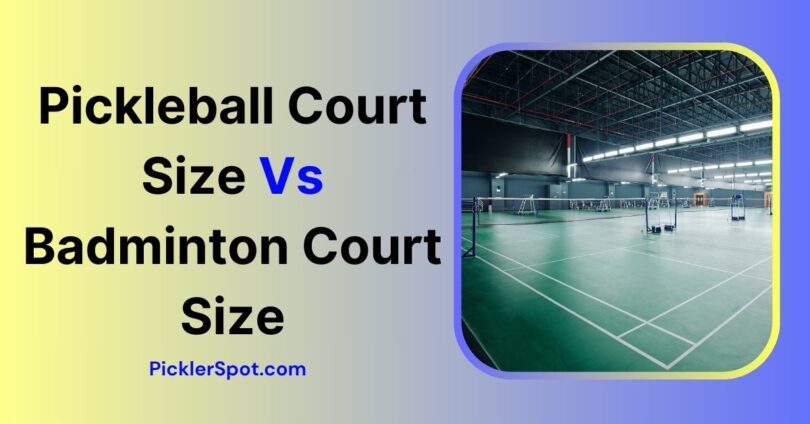There are striking similarities between Pickleball and badminton courts, which are so minuscule that if you take a magnifying glass, you would have a hard time spotting one, yet both of the core mechanics are surprisingly different.
In fact, the latter requires considerably more higher cardiovascular endurance and integrity than the former, nevertheless, both fall under the spectrum that easily terms them as a social game.
If you are interested in finding out esoteric details regarding Pickleball Court Vs Badminton Court, I would highly suggest that you scroll right down below because there is a whole chunk of information that would clearly blow you away.
Court Dimensions & Its Intricacies
Make sure you don’t skip through any detail especially if you want to build your own Pickleball court.
Surface Area
One of my biggest pet peeves about a Pickleball court vs. badminton court is that both of them share the same dimensions, in fact even if you measure it with a scale, you would know that both of these courts are 44 feet long while being 20 feet wide.
However, as per badminton’s official court rules, in singles format, players are required to utilize the court with its dimensions shrunken to 17 feet, reducing it by 3 feet which might not be much in a theoretical sense, but once you step in the court, you would notice a drastic reduction especially during mobility.
Surface Material
Most indoor courts nowadays use laminated wood, a type of plywood similar to the one used in commercial gyms.
However, if you are looking to join a premium club or build your own Pickleball court, the high traction court could work wonders considering the fact they are made to absorb only a fraction of shock wave from the impact of the ball, so it has optimal bounce frequency.
Both Pickleball and badminton have similar court surfaces in outdoor settings too, since they are made on concrete or asphalt surfaces to provide enough friction for the shoes of players enhancing mobility.
Concrete also prevents flora from being grown over the court, minimizing the need to maintain the court every now and then. It also provides a leveled field, so the rainwater won’t deluge it in case your court lacks a proper sewage system. Although there are some workarounds where you could play Pickleball on grass, the general rule of thumb is to utilize or build courts on concrete slabs for optimal experience.
Court Markings & Zones
This is where things get tricky as most of the details are often overlooked by a rookie player when stepping into either of these courts.
In a badminton court, the lines that act as an indicator run across along the back and sidelines, meanwhile using intermittent lines that resemble much like a tennis court.
To top it off, the pickleball court also has a Non-volley zone which is approximately 7 feet in length and is present at both sides of the court right beside the net.
This specific zone which is also known as Kitchen prevents players from volleying directly across the net.
Unlike Pickleball, badminton lacks such zones which is why the server box ranges all the way up to the net, and there is no particular rule that prohibits a player from volleying directly.
Net Height
Another massive difference when comparing Pickleball vs badminton is the height of the nylon mesh court that segments the court into two equal halves.
Pickleball players have to work their way around the 34 inches net which is a bit raised at the center post measuring at a steep 36 inches.
The net height is lenient as compared to other sports as it allows players to pull off strategies that enable them to keep the ball low to put their opponent off guard.
On the other hand, badminton enables players to reach way higher, almost above the waistline as the nylon mesh hangs over 5 feet and 1 inch. There are some discrepancies in the length of the net around the post down to the mid-region, nevertheless, it is considered trivial.
Player Occupancy
Both sports can accommodate teams of two players, unless and until you are playing in round robin format where you could interchange players, however, the maximum capacity of 4 remains the same throughout the session.
The Pickleball court has a special baseline, where players have to serve the ball diagonally across the court. This baseline is indicated by a line that is painted on the court onto the epoxy surface.
Although both players could stand on the same side, which is also known as stacking, the general rule for doubles format designates each player their own spot.
In Pickleball only a server can score a point and they are required to call out the score loudly before serving the ball across the net.
In Badminton, the entire baseline is basically a server’s haven, allowing players to serve or receive the shuttlecock regardless of the region they are standing in.
Can three Players play in A Court At A Time?
Yes, both Pickleball and badminton courts support the trio’s format, however, after each point, the third has to change teams. Subsequently, there are some instances where each player has their own independent scoring system, allowing every player to play for themselves instead of playing in the team.
Keep in mind this format isn’t compatible with official leagues as it might create imbalance, so in other words trios should only be limited to recreational purposes or for practicing in drills.
Pickleball Court Size Vs Badminton Court Size – Final Word
Ultimately, if you are looking for an athletic challenge that will give you a run for your money all while shedding huge chunks of calories, Badminton court is something you should look out for.
But on the flipside, the unique appeal and its newer core mechanics would absolutely have you head over heels, especially if you consider the fact that it has a lower learning curve making it easier to get into the game with prior experience or instincts.
Subsequently, the above-mentioned court knowledge would not only make you better at the game but you would also look pretty cool among your peers and even provide coaching service all while earning a buck along the way.









